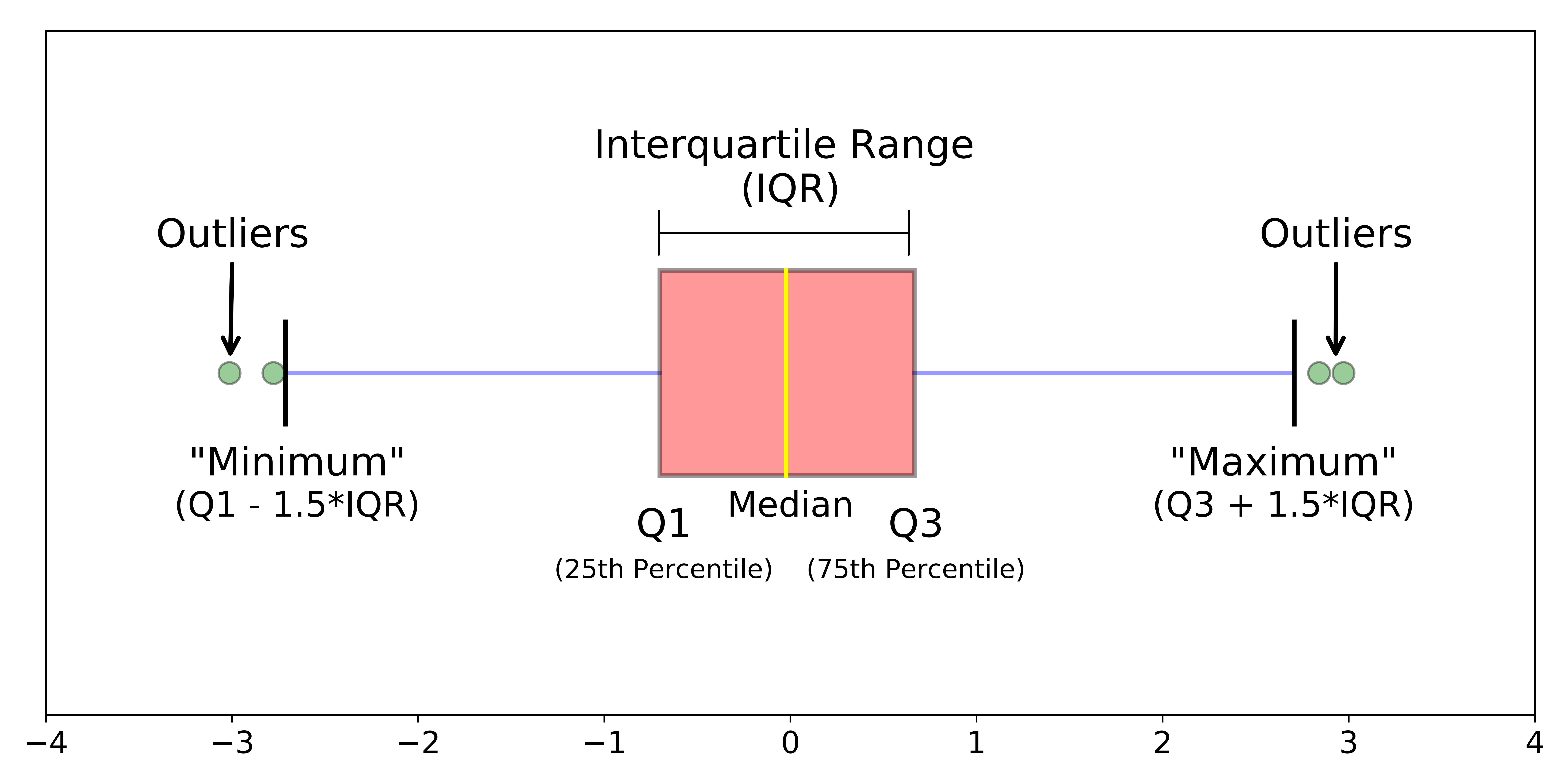This is a note that I wrote while learning the basics of machine learning to do my network management project course.
Part 1: How to read some basic plots
How to read box plot and density plot
Boxplot
- How to read boxplot [towardsdatascience]
 Image source: Michael Galarnyk on towardsdatascience
Image source: Michael Galarnyk on towardsdatascience
Boxplot shows:
- Median (Q2)
- Q1
- Q3
- The box is actually interquartile range (IQR) =
Q3 - Q1 - Minimum (
Q1 - 1.5 * IQR) - Maximum (
Q1 + 1.5 * IQR) - Outliers: data that is very different from the others [wikipedia]
Density plot
What is density plot: towardsdatascience.com.
- x values: like those of histogram
- y values: hmmm…
Some hints for y:
- The area under the curve represents the probability of getting an x value between a range of x values [stackexchange]
- Watch this if the first point does not make sense: [khanacademy]
- Another article: [towardsdatascience]
Supervised vs unsupervised learning
In a nutshell:
- Supervised learning: there is label/result on the training data.
- Unsupervised learning: there is no label/result on the training data.
In other words:
- Supervised learning: \( {(X_t, Y_t)} \longrightarrow M : X \rightarrow \hat y \)
- Unsupervised learning: \( {X_t} \longrightarrow M_\theta(X) \)
Building a model with validation-set approach
Given a dataset of n observations, model M learns from the training set, and it is evaluated with the test set. The sum of the number of observations in the training set and the test set is equal to n.
The training set and the test set should be picked uniformly random from the dataset. Usually, the training set size is larger than that of the test size.
import pandas as pd
from sklearn.model_selection import train_test_split
X = pd.read_csv('data/X.csv')
Y = pd.read_csv('data/Y.csv')
# set the training size to 70% of the dataset,
# and test size of 30% of the dataset
X_train, X_test, y_train, y_test = train_test_split(x,
y, training_size=0.7)
Evaluation metric: Mean Squarred Error (MSE)
\[MSE = {1 \over m}\sum_{i=1}^m || y^{(i)} - M(x^{(i)}) || ^ 2\]\(m\) = number of observations.
This is also called cost function \( J(\theta_0, \theta_1, …, \theta_n) \).
Part 2: Linear Regression
What is linear regression?
A good video to watch: [Andrew Ng].
The terms we are going to use:
xis the feature/input of the model. It can be 1 or more.yis the result of the model computation.
For example, in a dataset from a web server observation, we can have:
- \( x_1 \): CPU percentage at a particular time
- \( x_2 \): memory usage at a particular time
- \( x_3 \): iowait at a particular time
- \( y \): web server response time in millisecond
By the way, the \( x \) in the above example can be obtained from sar command in Linux.
In a nutshell, based on the data in the training set, we want to build a linear equation so that we can calculate/predict the new value of \( y \) given only \( x \).
So, in our example, the linear regression model is:
\[\hat y = M_\theta = \theta_0 x_0 + \theta_1 x_1 + \theta_2 x_2 + \theta_3 x_3 = \theta^\mathsf{T}x\]\( x_0 \) is 1, \( \theta_0 \) is called offset (offset -> the \( y \) value when \( x=0 \)). The \( \theta^\mathsf{T}x \) is a matrix multiplication of \( \theta^\mathsf{T} \) (transponse of matrix \( \theta \), a 3x1 column matrix) with matrix \( x \) (a 1x3 column matrix).
Least square regression tries to find model coefficients \( \theta_0, \theta_1, …, \theta_n \) so that the MSE is as small as possible.
To minimize the error when choosing coefficients \( \theta \), the steps are [Andrew Ng]:
- Start with some \( \theta_0, \theta_1, …, \theta_n \) (usually they are initially set with 0)
- Keep changing the coefficient \( \theta \) to reduce the cost function \( J(\theta) \) until hopefully end up at a minimum. This is done with gradient descent algorihtm.
Gradient descent algorithm:
\[repeat\ until\ convergence\ \{ \theta_j := \theta_j - \alpha {\partial \over \partial \theta_j} J(\theta_0, \theta_1, ..., \theta_n) \}\ for (j = 0\ to\ j = n)\]With \( \alpha \) is the learning rate and \( {\partial \over \partial \theta_j} J(\theta_0, \theta_1, …, \theta_n) \) is the derivative term.
How to build a linear regression in Python using Scikit-Learn
from sklearn.linear_model import LinearRegression
from sklearn import metrics
regression_model = LinearRegression()
regression_model.fit(X_train, y_train)
y_predict = regression_model.predict(X_test)
# print the coefficient
print(regression_model.coef_)
# print the intercept
print(regression_model.intercept_)
# print the MSE
print(metrics.mean_squared_error(y_test, y_predict))
Part 3: Classification - Logistic Regression
What is logistic regression?
Explanation: [Andrew Ng]
Logistic regression is used for classification. For example, it can be used to classify whether an email is a spam or not.
The model of the logistic regression is:
\[M_\theta(x) = \sigma(\theta^\mathsf{T}x)\]Whereby
\[\sigma(z) = {1 \over {1 + e ^ {-z}}}\]Notice that \( \theta ^ \mathsf{T}x \) is the same as that in the linear regression.
\( \sigma(z) : \real \rightarrow (0, 1) \) is the sigmoid/logistic function.
The interpretation of \( M_\theta(x) \) is the estimated probability that \( y=1 \) on input x [Andrew Ng].
Logistic regression in Python using Scikit-Learn
from sklearn.linear_model import LogisticRegression
logistic_regr = LogisticRegression(C=1e5, solver='lbfgs',
multi_class='multinomial')
logistic_regr.fit(X_train, y_train)
prediction_result = logistic_regr.predict(X_test)
Classification: True vs. False and Positive vs. Negative
A very good explanation for true-false-positive-negative: [developers.google.com]
In a nutshell:
- True positive (correctly says something is true)
- Reality: true
- System says: true
- True negative (correcly says something is wrong)
- Reality: false
- System says: false
- False positive (incorrectly says something is true, but it is actually false)
- Reality: false
- System says: true
- False negative (incorrectly says something is false, but it is actually true)
- Reality: true
- System says: false
Confusion Matrix
See [developers.google.com].
Part 4: Reducing the features (X values)
What if the number of features (\( x \)) is so large that it will take so long to compute, send the raw data, and hard to save on the drive?
We might want to exclude some features in the training and test size. One of the ways to do it is ask the expert of the field which features really matter. For example, in the dataset from the web server operation, we can ask the infrastructure guys which metrics that can affect the performance of the server. However, if the data is too large and no one knows for sure which features matter, we can reduce the features using the following techniques.
Optimal Method: Build all subsets of the feature set X
From the n number of fetures, build models from the subset of all features, then choose the features which yields the smallest error. This exhaustive search has the complexity of \( O(2^n) \).
import itertools
def subs(l):
res = []
for i in range(1, len(l) + 1):
for combo in itertools.combinations(l, i):
res.append(list(combo))
feature_names = [
"cpu_percentage",
"memory_usage",
"iowait"
]
all_subset = subs(feature_names)
Heuristic Method: Linear univariate feature selection
Basic idea: choosing the features based on the correlation values of the feature. The correlation value falls into the interval \( [-1, +1] \)
# "target" is the feature of the result y
corr_values = my_data.corr()["target"]
print(corr_values)
abs_corr_values = abs(corr_values)
print(abs_corr_values)
How to read the correlation values [statisticsbyjim]:
- The absolute correlation value determines the strenth; the closer the absolute value to 1, the stronger it is to the \( y \)
- The sign (negative or positive) represents the direction of the relationship.
